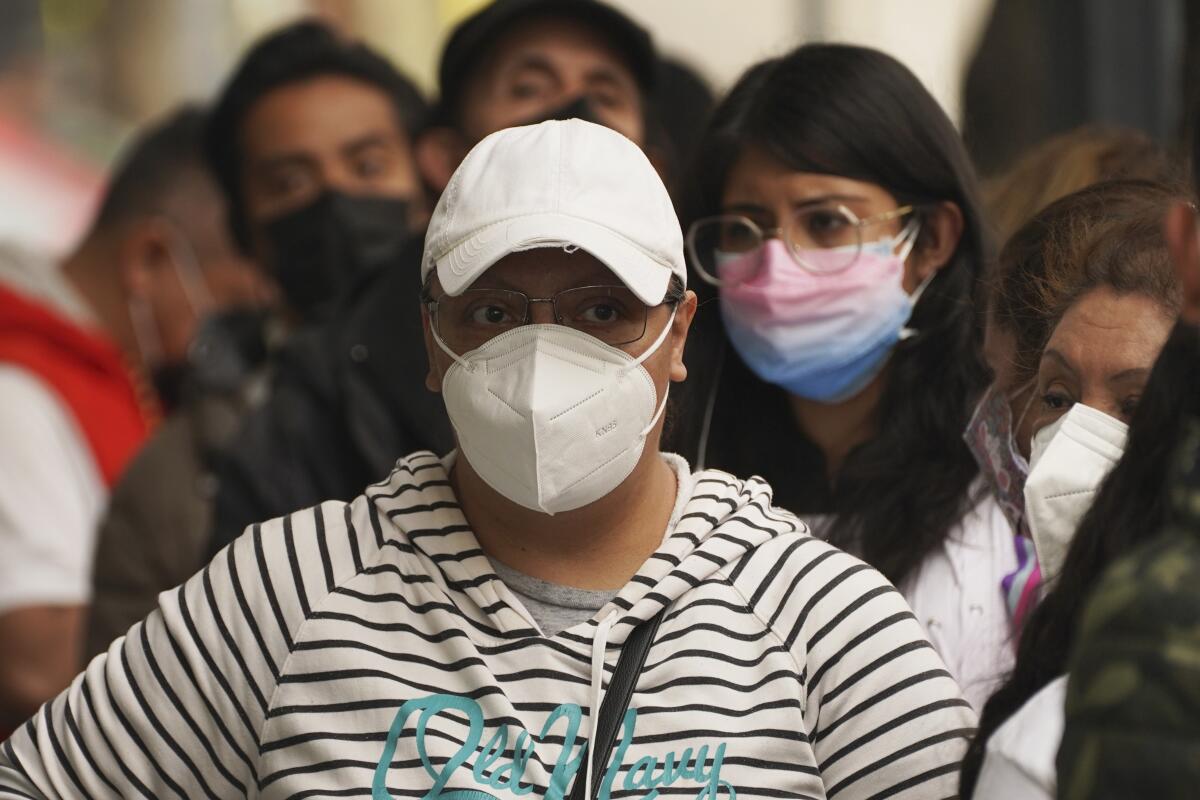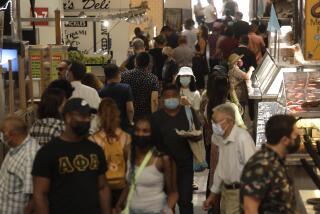Mexico weathers the Omicron surge, but experts warn against complacency

- Share via
MEXICO CITY — After he came down with a cough and his doctor recommended he be screened for COVID-19, Alejandro Cruz Esteban spent three days standing in long lines trying to get a coronavirus test.
By the time he finally got one, he already felt much better and was no longer worried that he had the virus.
Instead, he was worried that he didn’t have it.
“If I’m negative, how am I going to justify missing days of work?” wondered the 49-year-old retail clerk and father of three.
Mexico, like much of the world, is experiencing a record spike in coronavirus cases as a result of the highly transmissible Omicron variant.
But compared to the surge last January, which overwhelmed intensive care units and cemeteries, spawned a black market for oxygen and killed Cruz’s father, this latest phase of the pandemic has so far taken a much milder toll on Mexico.
Long lines for tests have supplanted packed hospital wards as the signature image of Mexico’s current incarnation of the virus, which many here say feels less like a death threat than a nuisance.
Many people are missing work or school as infections and fear spread. The newspaper El Universal estimated that as many as 15% of employees in public transport, manufacturing and other sectors may be off the job in Mexico City.
But deaths and hospitalizations are nowhere near their high points.
“This variant of COVID doesn’t have the lethality, the danger of the previous variant, the so-called Delta,” a smiling President Andrés Manuel López Obrador declared in a video address last week after disclosing that he had recuperated from a second bout of the coronavirus with nothing more than Vicks VapoRub and other over-the-counter cold remedies.
“This variant produces very mild symptoms, the equivalent of a flu,” he said. “I’m very pleased because it means that this pandemic is on its way out.”
Experts said that is wishful thinking.
While they credit widespread vaccination — with rates comparable to those in the United States — for reducing serious illness and death, they warn that the situation is likely to become far more dire as the country comes to experience the full impact of the current wave.
“Those who consider the Omicron variant as just a little cold are mistaken,” Dr. Alejandro Macias, an infectious disease specialist who led Mexico’s response to the 2009 swine flu pandemic, said this week on Twitter. “There will still be more cases and more deaths. Hospitals and intensive care [wards] will still be filling up.”
On Wednesday, Mexico logged 60,552 new coronavirus cases, breaking the record of 49,343 set a day earlier.
Hospitalizations have risen in recent weeks, but nationwide hospitals are only 37% full — far shy of the the 61% level reached a year ago. In Mexico City, more than 80% of hospitalized COVID-19 patients are unvaccinated.
As for deaths, the official daily average during the past week is about 193 — up from mid-December, but less than a fifth of last year’s daily peak of more than 1,000,
Still, the current trends are unsettling enough that scientists have renewed calls for precautions aimed at reducing the spread.
Unlike the United States and many other nations, Mexico still does not require travelers arriving from abroad to present negative coronavirus tests. Face-covering requirements are mostly voluntary. Both foreign and domestic tourists have been flocking to Mexican beaches and night spots, and López Obrador’s government has shown little willingness to impose new restrictions.
“They are letting the virus circulate in an indiscriminate manner, no one is asking for tests to enter anywhere, nothing is closed,” Rodrigo Jácome, a virologist at the National Autonomous University of Mexico, told La Razón newspaper. “What this demonstrates is the absence of a strategy.”
Mexico’s official death toll from COVID-19 is slightly more than 300,000. But studies looking at “excess deaths” — the number of people who have died recently compared to years preceding the pandemic — suggest that the actual death toll in Mexico may be double or more the official tally.
And because the government has long deemphasized testing — Mexico has one of the world’s lowest testing rates — the country has never had a good handle on how many people are infected.
Testing sites are now swamped.
“If you arrive on this line without COVID, you will surely leave with COVID,” said Esther Galindo Suárez, 32, a receptionist who was among scores in line outside a public clinic offering free tests in Mexico City. “There is none of the famous social distancing here. And the only thing one hears is people coughing and blowing their noses.”
She said she had no symptoms, but that her employer obligated her to get tested.
“With this terrible organization, the only thing the government is accomplishing is ensuring more cases of COVID,” Galindo said. “If I had the money, I’d get out of this place right away and go to a private clinic.”
As for Alejandro Cruz, he ultimately tested positive, and his cough has returned — which he blames on having had to wait in the cold for tests.
His 16-year-old daughter and 20-year-old son — both college students studying from home — also have symptoms. But Cruz discouraged them from getting tested and exposing themselves to people in the lines.
“It’s not true what López Obrador says, that this variant is very mild and it goes away in only three days if you use VapoRub,” Cruz said. “At least not if you have to leave early in the morning to get on a line for hours to be tested.”
McDonnell is a staff writer. Sánchez is a special correspondent.
More to Read
Sign up for Essential California
The most important California stories and recommendations in your inbox every morning.
You may occasionally receive promotional content from the Los Angeles Times.











